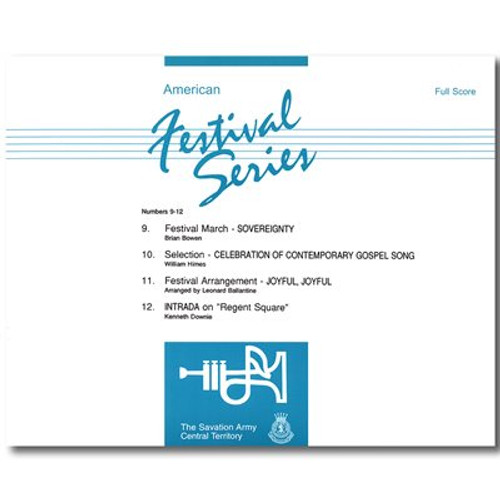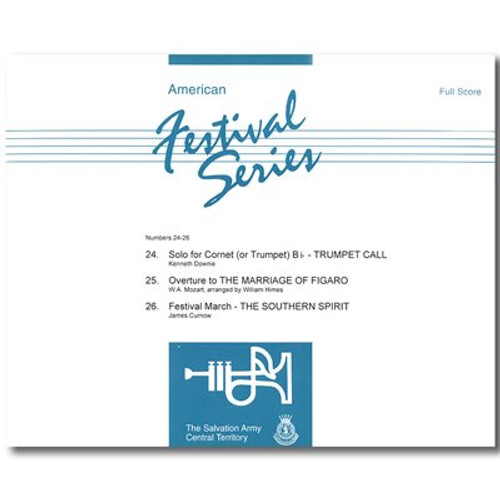Product Description
November 1990 - Nos. 9-12
Comments by
Staff Bandmaster William Himes
Music Secretary, USA Central Territory
Score Sample
9. Festival March - Sovereignty Brian Bowen Notes 10. Selection - Celebration of Contemporary Gospel Song William Himes Notes 11. Festival Arrangement - Joyful, Joyful arr. Leonard Ballantine Notes 12. Intrada on "Regent Square" Kenneth Downie Notes
(sample music)
(view series guide)
Produced by The Salvation Army - Central Territory9. Festival March - Sovereignty
Program Note:
Written to commemorate the New York Staff Band's centennial anniversary in 1987, tihs bright and majestic march features the chorus, "Make Jesus King."Note to the Conductor:
If there is anything one can expect of the music of Brian Bowen, it is the unexpected. While following the traditional march form, this work abounds with rhythmic and harmonic diversity and will require thorough rehearsal to achieve a convincing performance.
Intro: Strive for an accurate shift between duple and compound rhythms presented in the opening measures, saving a brilliant burst of brass for bar 6.
Bars 7-17: Overall, this strain should be light and carefree, avoiding the tendency to "hammer away" at 16th notes (semi-quavers). Trombones should bring out their solo moment in the 1st ending with a firm marcato style.
Bars 18-30: As this lilting melody is brightly presented, the 1st cornet must be careful to blend into the mellow timbre of flugel and horns. The rambunctious ff response which follows should come as a surprise and recede just as suddenly. Strive for precision from cornets, trombones and basses at bar 30, beat 4.
Bars 31-42: The chorus, "Make Jesus King", is presented in a straightforward manner. Be careful to bring volume to an understated mf at bar 35 to heighten the contrast of the second statement in the section which follows.
Bars 43-54: While playing their rolling eighths (quavers), euphoniums and basses should give emphasis to the string beats (1 & 3) in bars 43-46. Avoid the tendency for cornets to rush their ascending pattern as they reach the upper register in bars 49-50.
Bars 55-64: A return to the theme of the first strain follows with a bit of gymnastics added by the euphonium, which should endeavor to sound light and effortless, especially in bar 57.
Bars 65-80: While the melody (1st baritone, euphonium) is a model of simplicity, a proper sense of phrasing, leading to the first beat of each bar, is essential to bring this theme to life.
Bars 81-88: There are basically three independent elements of this "break strain" which will require individual attention followed by coordination and integration:
1) the tune motif (trombones)
2) ascending 16ths (semi-quavers) (cornets, euphonium)
3) marcato fanfare (1st cornet, horns, baritones).
Bars 89-100: Clarity of scoring will be most effective when the sostenuto style of the melody (1st/2nd cornets, flugel and baritones) and ascending scales (solo cornet, euphonium) is contrasted with the percussive effects (soprano, solo/1st horns, trombones, basses and percussion.) Be sure to bring out the trombone motif in bars 97-100.
Bars 101-end: The conclusion is an amalgam of virtually all the melodic elements introduced. Savor the brilliant half-note chords in bars 103-104 while giving priority to the tune motif appearing in the low brass (bars 103-104 and 109). The final bars should be majestic and dramatic.10. Celebration of Contemporary Gospel Song
Program Note:
This colleciton focuses on six gospel melodies, all written in recent years and all found in standard church hymnals - a testimony of their usefulness to the twentieth century church. The arranger has included melodies of diverse origin and idiom, including "Because He Lives," "Get All Excited," "Happiness is the Lord," "O how He loves you and me," "Easter Song" and "My Tribute."Note to the Conductor:
Grateful acknowledgement is expressed to the copyright holders of the six songs included in this selection for their kind permission in allowing their music to be included herein.
Intro: The opening theme, "Because He lives, I can face tomorrow," establishes the scene for a musical sunrise. Aim for a soft, legato approach, with a controlled crescendo hitting its peak at bar 15.
Bars 15-60: Again, the sudden burst of energy in this section is dictated by the theme, "Get All Excited." Articulations have been provided with meticulous detail to help achieve a driving, punctuated style. The tambourine entry at bar 27 will help establish the light rock idiom. Be sure the percussionist uses the correct technique needed, shaking the tambourine from side to side in rhythm, striking the rim to achieve accents on beats 2 and 4.
Bars 61-76: The scene quickly changes with a return to the opening theme, this time in the solo trombone, performing with a smooth, jazz ballad style. Percussion will add to the mood with subdued use of brushes on snare.
Bars 77-92: In addition to the priority of the melody (solo cornet, flugel, trombones) and the grandioso accompaniment, keep these elements in balance so that the dialogue between soprano and 1st cornet comes through with clarity.
The Bb bass introduces a relaxed swing style at bar 91. Accompanying cornets and trombones must synchronize their "push beat" at the end of this bar with the ongoing bass melody.
Bars 93-126: Strive for an easy-going triplet feel to the eighths (quavers) throughout this swing section. Avoid the tendency to succumb to the enthusiasm of the style by overstating the dynamics. The crescendo at bar 108 goes only to f, holding some volume in reserve for the ff at 117. The trombone "fall-offs" beginning at bar 117 are not merely effects, they should be balanced chords as well.
Bars 127-177: Although the setting of "O how He loves you and me" is treated with appropriate simplicity, don't shy away from the expressive opportunities here, especially when slentando is indicated.
Bars 178-260: Again, a sudden shift of style occurs, this time leading into a graceful waltz. With this in mind, don't allow the scalic countermelody at bar 211 (soprano, flugel, horns) to overshadow the pulsating theme (solo cornet). Keep the tempo under control, as this will make it easier to achieve the final transition to the gospel 12/8 style called for at bar 261.
Bars 261-276: Percussion is a vital factor in establishing a convincing gospel style, with strong accents throughout on beats 2 and 4.
Bars 277-end: The conclusion should be fleeting and proportioned, allowing the layering of rhythmic motifs to overtake one another, saving the peak fff for hte final bar.11. Festival Arrangement - Joyful, Joyful
Program Note:
The arranger, a Canadian Salvation Army officer, has taken the well known theme from Beethoven's Ninth Symphony and cast it in a delightful contemporary idiom.Note to the Conductor:
This sparkling arrangement certainly lives up to the credo of this publication: festival series music need not be difficult to be festive. The music is energetic and straightforward, with few technical challenges.
It might be of interest to point out that this arrangement was originally written as an accompaniment for massed chorus.. A complimentary copy of the vocal arrangement is included with this publication and can serve as a master copy.12. Intrada on "Regent Square"
Program Note:
A spacious and regan theme, frequently associated with the Advent hymn, "Angels from the realms of glory," is given a brilliant orchestration worthy of its majesty. The tune, composed by Henry Smart in 1867, is named after the Regent Square Church of London, where the composer served as organist.Note to the Conductor:
This scoring exploits a wide range of color and texture within its brief 38 bars. Because it is essentially a fanfare, care must be taken to avoid overblowing the dynamics, saving best and fullest sonorities for the dramatic conclusion.
Students of orchestratoin will be particularly intrigued with the score of the Eb bass in the upper register, particularly in bars 14-18 and 27.
The triplet quarter (crotchet) entries beginning at bar 23 (trombones, 1-2 cornets) can pose a challenge to players unaccustomed with this rhythmic figure. They are more likely to succeed sooner if they play this by feel, rather than by calculation.








